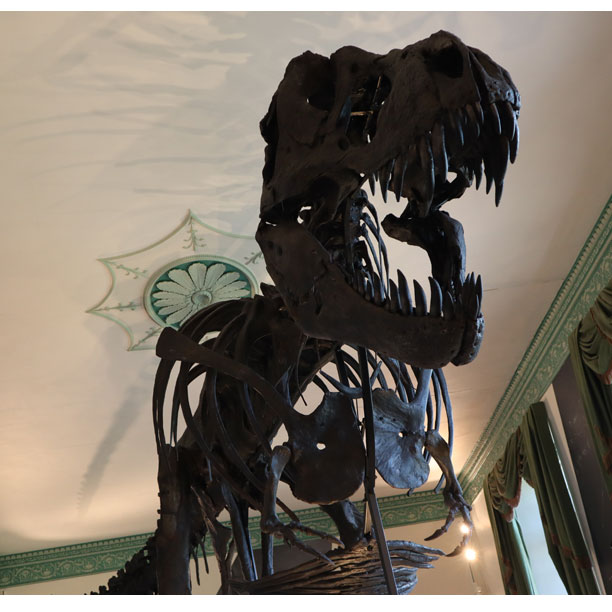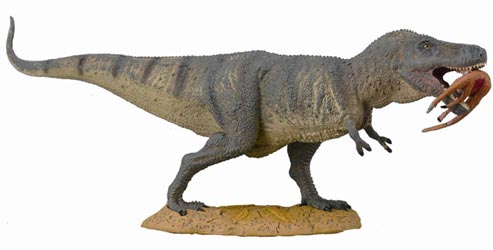T. rex Slow Coach Once Again
Palaeontologists have long debated the potential running speeds of big, theropod dinosaurs. Indeed, the question as to whether bipedal giants like Tyrannosaurus rex, Giganotosaurus, Mapusaurus and Carcharodontosaurus could run at all has been muted. Thanks to some new research from Manchester University, a better understanding of dinosaur locomotion could be within our grasp.
New T. rex Study Suggests Giant Theropods Could Not Run Fast
The picture shows a Tyrannosaurus rex with an ornithomimid (Struthiomimus), in its mouth. This new study concludes that there is no way that a T. rex could pursue and catch such a fleet-footed dinosaur as an “ostrich mimic”. In this case, perhaps this hypercarnivore stumbled across the carcass of a Struthiomimus, we can expect the “hunter versus scavenger” debate to be re-ignited as a result of these research findings.
The model in the image is from the CollectA Prehistoric Life range.
To view this range: CollectA Age of Dinosaurs Prehistoric Life Models.
If T. rex Tried to Run Fast it Could Break its Legs!
According to lead author of this new, scientific paper, Professor Bill Sellers (School of Earth and Environmental Sciences), T. rex could not run, it was just too large and heavy. Tyrannosaurus rex was unable to pursue prey at high speeds – no chance of catching Jeff Goldblum et al in the famous jeep chase in Stephen Spielberg’s ground-breaking “Jurassic Park”. In addition, this new research suggests that T. rex walking speed was limited, had it tried to quicken its pace, it was in danger of breaking its legs.
This new study means that scientists will have to reconsider how T. rex might have behaved. We at Everything Dinosaur know, that the BBC are bringing out a new documentary on the “Tyrant Lizard King”, this is due to be shown at Christmas. Will this new research change the script?
New Biomechanical Study of Tyrannosaurus rex Locomotion Limits Dinosaur Velocity
Picture credit: University of Manchester
The Gait and Biomechanics of the World’s Most Famous Dinosaur
The research team used a combination of two separate biomechanical assessment techniques coupled with sophisticated computer programming to model locomotion results. The biomechanical techniques, known as multibody dynamic analysis (MBDA) and skeletal stress analysis (SSA), in conjunction, create a new, more accurate assessment of T. rex and its cursorial abilities.
The size and weight of an adult T. rex means that it could not move at high speed, its leg bones would have buckled under its own colossal weight. N8 High Performance Computing (HPC), was used to create a three-dimensional model of the skeleton and to assess the forces involved as this giant predator was put through its paces. Running did not end well for the T. rex, had this monster survived to the present day, it seems that most of us humans could have easily out run it. The paper, published in the academic journal “PeerJ”, suggests a top speed of around 12.5 mph (20 km/hour) for Tyrannosaurus rex.
Not Capable of Running Fast
Previous studies, that predicted running speeds of up to 45 mph for very big theropods have been de-bunked. Running at such a speed would have placed “unacceptably high skeletal loads” on the animal, T. rex would have broken its legs had it attempted to sprint.
Professor Sellers explained:
“The running ability of T. rex and other similarly giant dinosaurs has been intensely debated amongst palaeontologist for decades. However, different studies using differing methodologies have produced a very wide range of top speed estimates and we say there is a need to develop techniques that can improve these predictions. Here we present a new approach that combines two separate biomechanical techniques to demonstrate that true running gaits would probably lead to unacceptably high skeletal loads in T. rex.”
Tyrannosaurus rex – A Lumbering Giant

The spectacular Titus the T. rex exhibit at Wollaton Hall. Tyrannosaurus rex a lumbering giant. Picture credit: Everything Dinosaur.
Picture credit: Everything Dinosaur
Challenging Perceptions about T. rex
This new study challenges the way in which T. rex and similarly sized theropods could have behaved. High-speed chases were out of the question. It is likely that these predators were limited to walking speeds, a direct contradiction to the fast-moving, highly cursorial depiction seen in some movies and postulated by other researchers. The University of Manchester team may have concentrated on the largest tyrannosaurid, but this research has implications for other super-sized theropods too. The scientists conclude that other large, bipedal dinosaurs, predators such as Giganotosaurus, Mapusaurus and Acrocanthosaurus were also slow coaches.
Acrocanthosaurus Too – Likely to be a Slow Coach
Picture credit: Everything Dinosaur
Professor Sellers added:
“Tyrannosaurus rex is one of the largest bipedal animals to have ever evolved and walked the earth. So, it represents a useful model for understanding the biomechanics of other similar animals. Therefore, these finding may well translate to other long-limbed giants so but this idea should be tested alongside experimental validation work on other bipedal species.”
This is not the first time MBDA and SSA methodologies have been used to measure the walking and running ability of dinosaurs. However, it’s the first time they have been used in conjunction to create a more accurate picture of potential locomotion.
The professor concluded:
“Our previous simulations of theropod bipedal running did not directly consider the skeletal loading but these new simulations do calculate all the forces in the limb bones and these can be used directly to estimate the bone loading on impact.”
The Research Implications
If Tyrannosaurus rex and other large theropods were essentially limited to walking, then this study directly contradicts those arguments for a more athletic, active lifestyle for these huge carnivores. Unable to pursue prey, this suggests that a fully-grown Tyrannosaurus rex may have been an ambush predator or perhaps entirely reliant upon a durophagous existence, crunching the bones and feeding on the carcasses of dead dinosaurs.
This study suggests that palaeontologists may have to change their views on the effects of body size and shape as large, bipedal dinosaurs grow. Earlier research has suggested that the torso became longer and heavier, whereas the limbs became proportionately shorter and lighter as T. rex grew. These changes would mean that the running abilities of T. rex would also change as the animal matured, with adults likely to be less agile than younger, lighter individuals.
Could a Large Theropod Really Run Fast?

A Papo green running Tyrannosaurus rex model on display next to a replica of a T. rex tooth and a T. rex claw. An exhibit at the Manchester Museum of Natural History. Picture credit: Everything Dinosaur.
If this dinosaur was limited to a walking speed, then images of T. rex as an agile, active predator could be highly inaccurate.
This new paper, is likely to spark a debate once more about the lives of these iconic prehistoric animals. A spokesperson from Everything Dinosaur commented:
“The problem is, whilst we have large quadrupeds to study, animals such as elephants and rhinos, there is simply no extant equivalent of a huge, bipedal dinosaur! This might be fortunate from a personal preservation perspective, but for palaeontologists, this poses a huge problem when it comes to considering how these creatures moved. Sophisticated biomechanical studies such as this one from Manchester University, provide probably the best chance we have when it comes to unravelling the mysteries of dinosaur locomotion.”
The scientific paper: “Investigating the Running Abilities of Tyrannosaurus rex Using Stress-constrained Multibody Dynamic Analysis” by William I. Sellers, Stuart B. Pond, Charlotte A. Brassey, Philip L. Manning, and Karl T. Bates
To read a selection of other articles looking at the running abilities of various dinosaurs:
T. rex Could Run at Nearly Eighteen Miles per Hour!
Dinosaurs at the Movies – the Anomalies of “Jurassic Park”.
Visit the award-winning Everything Dinosaur website: Everything Dinosaur.









I have seen a television show that postulated it was the long legged sub-adult T-rex that did the chasing–driving the terrified prey to their elders–and the awesomely powerful adults that did the killing with their gaping maws and bone-crushing teeth, so this is not really news nor is it a comprehensive (as in T-rex social orders) picture of what might have been.
Simply put, anything as large as T-rex (presumably warm blooded as well) is unlikely to have survived by waiting to find another carcass, unless it had the presence of mind to consistently intimidate (without killing) smaller predators.